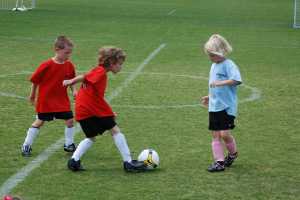17 Jan “11+ Kids” Program Reduces Soccer Injuries in Children
MedicalResearch.com Interview with:
 Roland Rössler PhD
Roland Rössler PhD
Postdoctoral Fellow
Dept of Public and Occupational Health
Amsterdam Collaboration on Health and Safety in Sports
VU University Medical Center
MedicalResearch.com: What is the background for this study?
Response: Previous studies have shown that exercise-based injury prevention programmes can reduce the number of sport injuries. However, no previous study investigated the prevention of football (soccer) injuries in children under the age of 14 years [1], even though the number of football players under 14 years of age could be estimated as around 15 million worldwide. In comparison, only about 100,000 players, so 150 times less, are considered professional players (earning enough money to live from playing football). The large number of children playing football and the fact that every year about 10% of these players sustain an injury, indicates the relevance of injury prevention in this population.
Based on the existing “11+” programme (that has been designed for players from the age of 14 years onwards) and our epidemiological data on injuries in football players under 14 years of age [2, 3], we developed and pilot tested an injury prevention programme for 7- to 13-year-old children (called “11+ Kids”) with an international group of experts.[4]
We designed the present cluster randomised controlled trial to evaluate whether the “11+ Kids” programme reduces the incidence of injuries in children’s football.
MedicalResearch.com: What are the main findings?
Response: The “11+ Kids” warm-up programme reduces the number of football injuries in children by 48% compared to a regular warm-up programme. Particularly large protective benefits were found for severe injuries (74%). Further, the mean duration of absence from sport participation due to injury was reduced in the intervention group. Importantly, also the total number of days lost to injury was considerably lower (less than half).
The compliance analysis showed a clear dose-response-relationship between the frequency of performing “11+ Kids” and the injury rate. The programme should be used at least once every week to profit from a protective effect and more often to maximise the benefits of the “11+ Kids” programme.
MedicalResearch.com: What should readers take away from your report?
Response: The injury prevention programme “11+ Kids” reduces football injuries in children. Considerable protective benefits were found for overall, severe, and lower extremity injuries.
We found that the effects were clearly related to compliance. Therefore, regular and frequent usage of the programme (at least once, but better twice per week) is key to profit from the preventive effect.
The “11+ Kids” is easy to apply and the acceptance amongst coaches and players is high. It takes on average about 18 minutes to complete and only requires a small part of a football field and one ball per player. As such, the programme should become an integral part of children’s football training by replacing the standard warm-up procedure.
MedicalResearch.com: What recommendations do you have for future research as a result of this work?
Response: Future studies should investigate the cost-effectiveness (cost of application in relation to the reduction of health-care costs) of “11+ Kids”. Also, the effectiveness of the programme in the real-world day-to-day application should be studied. Finally, the transferability of the “11+ Kids” to other (team) sports should be explored.
MedicalResearch.com: Is there anything else you would like to add?
Response: Promising effects of sport injury prevention have been reported for many different sports, age-groups, and for female and male athletes. Insurance companies worldwide should be motivated to invest in the implementation of existing programmes and should provide funding for further scientific studies on injuries and injury prevention.
The full article can be accessed here (open access): https://doi.org/10.1007/s40279-017-0834-8
Rössler, R., Junge, A., Bizzini, M., Verhagen, E., Chomiak, J., aus der Fünten, K., . . . Faude, O. (2017). A Multinational Cluster Randomised Controlled Trial to Assess the Efficacy of ‘11+ Kids’: A Warm-Up Programme to Prevent Injuries in Children’s Football. Sports Medicine. doi: 10.1007/s40279-017-0834-8
Twitter: @RolandRoessler
ORCID: https://orcid.org/0000-0002-6763-0694
References and further reading:
- Rössler R, Donath L, Verhagen E et al. Exercise-based injury prevention in child and adolescent sport: A systematic review and meta-analysis. Sports Med. 2014;44(12):1733-48. doi:10.1007/s40279-014-0234-2.
https://link.springer.com/article/10.1007%2Fs40279-014-0234-2
- Rössler R, Junge A, Chomiak J et al. Soccer injuries in players aged 7 to 12 years: A descriptive epidemiological study over 2 seasons. Am J Sports Med. 2016;44(2):309-17. doi:10.1177/0363546515614816.
http://journals.sagepub.com/doi/abs/10.1177/0363546515614816
- Rössler R, Junge A, Chomiak J et al. Risk factors for football injuries in young players aged 7 to 12 years. Scand J Med Sci Sports. 2017. doi:10.1111/sms.12981.
- http://onlinelibrary.wiley.com/doi/10.1111/sms.12981/abstract
- Rössler R, Donath L, Bizzini M et al. A new injury prevention programme for children’s football–fifa 11+ kids–can improve motor performance: A cluster-randomised controlled trial. J Sports Sci. 2016;34(6):549-56. doi:10.1080/02640414.2015.1099715.
https://doi.org/10.1080/02640414.2015.1099715
Citations:
Sports Med. 2017 Dec 22. doi: 10.1007/s40279-017-0834-8. [Epub ahead of print]
A Multinational Cluster Randomised Controlled Trial to Assess the Efficacy of ’11+ Kids’: A Warm-Up Programme to Prevent Injuries in Children’s Football.
Rössler R1,2, Junge A3,4,5, Bizzini M3,4, Verhagen E6, Chomiak J7, Aus der Fünten K8, Meyer T8, Dvorak J3,4, Lichtenstein E9, Beaudouin F8, Faude O9.
https://www.ncbi.nlm.nih.gov/pubmed/29273936
MedicalResearch.com is not a forum for the exchange of personal medical information, advice or the promotion of self-destructive behavior (e.g., eating disorders, suicide). While you may freely discuss your troubles, you should not look to the Website for information or advice on such topics. Instead, we recommend that you talk in person with a trusted medical professional.
The information on MedicalResearch.com is provided for educational purposes only, and is in no way intended to diagnose, cure, or treat any medical or other condition. Always seek the advice of your physician or other qualified health and ask your doctor any questions you may have regarding a medical condition. In addition to all other limitations and disclaimers in this agreement, service provider and its third party providers disclaim any liability or loss in connection with the content provided on this website.
Last Updated on January 17, 2018 by Marie Benz MD FAAD
